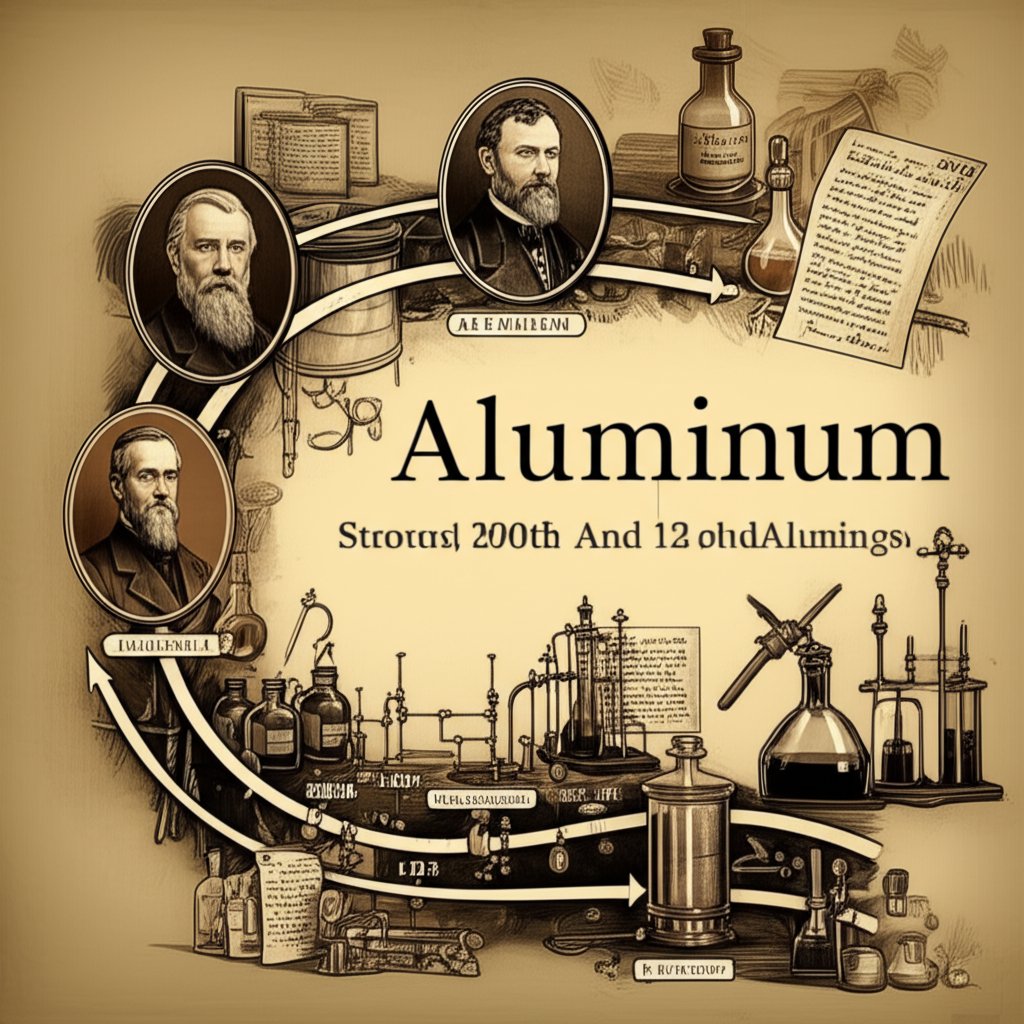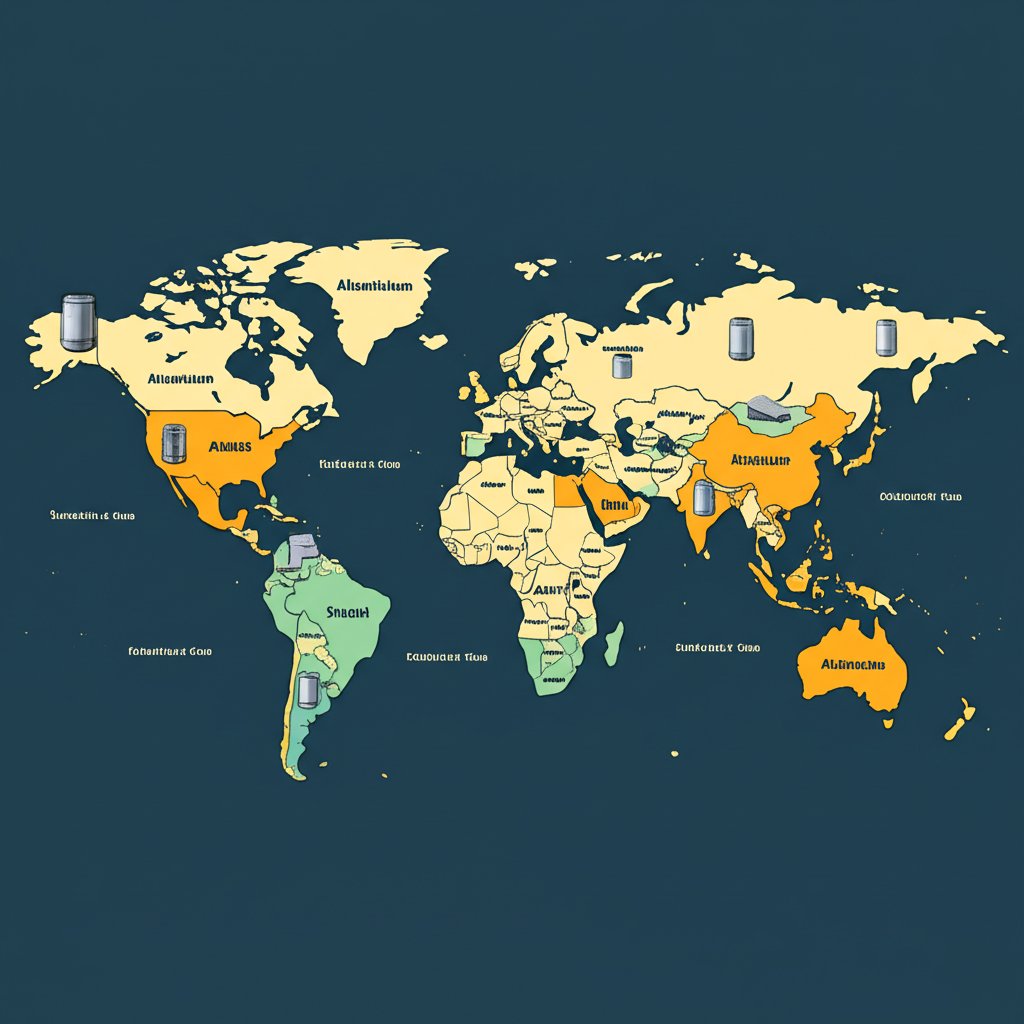
Have you ever wondered, is it aluminum or aluminium? If you’ve seen both spellings—on packaging, in textbooks, or even in science class—you’re not alone. This simple difference in spelling has puzzled students, professionals, and everyday consumers alike. Why do some people write "aluminum" while others insist on "aluminium"? And more importantly, which one is actually correct?
The answer might surprise you: both spellings are correct. However, they’re used in different parts of the world. In the United States, "aluminum" is the standard, while "aluminium" is favored in the United Kingdom and many other English-speaking countries. This regional split in language leads to frequent confusion, especially as global communication and international trade continue to grow. Imagine reading a recipe from the UK that calls for "aluminium foil" or seeing "aluminum" listed as an ingredient on a product made in the US—the difference can be subtle but noticeable.
So, why does this one element have two names? And how do you know which spelling to use in your writing or conversation? In this article, we’ll break down:
By the end, you’ll have a clear understanding of the aluminum or aluminium spelling debate, and you’ll be able to use the term that best fits your audience—without second-guessing yourself.

Ever opened a soda can labeled "aluminum" in one country, only to see "aluminium" on a foil package from another? If so, you’re not alone—this dual spelling pops up everywhere, from supermarket shelves to science textbooks. But why do we encounter both aluminum or aluminium so frequently, and what makes it so perplexing?
Imagine watching a cooking show from the UK and hearing the chef say, “Cover your dish with aluminium foil.” Then, later that day, you read an American recipe calling for “aluminum foil.” It’s the same product, but the spelling shifts depending on the source. This isn’t just limited to cooking:
This constant back-and-forth can leave you second-guessing: Is one spelling more correct than the other? Or should you adapt based on your audience?
The real issue arises as our world becomes more connected. Whether you’re a student, a professional, or simply browsing the web, you’ll notice both spellings in use. This dual presence creates uncertainty about which term to use—especially in global business, education, or online communication. As you continue exploring, you’ll see how these preferences developed and why both spellings remain widely accepted today.
When you see “aluminum” on a soda can or building material in North America, you’re witnessing the result of a long history of language evolution and scientific standardization. But how did “aluminum” become the accepted spelling in the United States and, often, in Canada? Let’s break down the story behind this regional preference and explore why the aluminum or aluminium spelling debate continues to matter.
Sounds complex? The answer lies in a mix of scientific tradition and linguistic practicality. The roots of the American spelling can be traced back to the early 19th century. When Sir Humphry Davy first identified the element, he experimented with several names, including “alumium,” “aluminum,” and later “aluminium.” However, it was the spelling “aluminum” that made its way into Noah Webster’s influential 1828 American Dictionary of the English Language. This early adoption gave the spelling a strong foothold in American English, especially as Webster’s dictionary became the go-to reference for American writers and educators (ANSI Blog).
What about our neighbors to the north? In Canada, you’ll often encounter “aluminum,” especially in science education and industry, thanks to the close ties with US standards and publications. However, “aluminium” isn’t entirely absent—Canadian English sometimes reflects British spelling conventions, so you might spot “aluminium” in academic writing or imported products. Still, the dominant spelling in Canadian industry and government documents is “aluminum,” echoing the American preference (ThoughtCo).
| Region | Common Spelling | Context/Notes |
|---|---|---|
| United States | Aluminum | Standard in scientific, industrial, and everyday use |
| Canada | Aluminum (mostly) | Some "aluminium" in academic or British-influenced contexts |
Ultimately, if you’re writing for or communicating with a North American audience, “aluminum” is the clear choice. But as you’ll see in the next section, the story takes a different turn in other parts of the world, where “aluminium” reigns supreme.
When you travel outside North America or browse international publications, you’ll quickly notice the spelling "aluminium" dominating packaging, scientific literature, and industry standards. But why does this version prevail in so many regions, and what’s the reasoning behind the extra "-ium"?
Imagine picking up a soda can in London, reading a research paper from Australia, or visiting a construction site in South Africa—chances are, you’ll see "aluminium" on labels and technical documents. This isn’t just a random preference. In the UK, Ireland, Australia, New Zealand, India, and most of the Commonwealth, "aluminium" is the accepted standard. Even international scientific literature and organizations, such as the International Union of Pure and Applied Chemistry (IUPAC), endorse this spelling for consistency with other element names (Seather Technology).
Sounds technical? The reason for the "-ium" ending is actually quite logical. In the 19th century, scientists wanted element names to align with classical Latin conventions. Many elements—think sodium, potassium, magnesium—end in "-ium." Adopting "aluminium" fit this pattern and gave the element a sense of scientific gravitas. This consistency is especially valued in international academia and industry, where standardized naming helps avoid confusion.
But what happens when products cross borders, or when companies serve customers worldwide? That’s where the spelling debate gets practical. International manufacturers, like Shengxin Aluminum, must adapt to regional expectations while maintaining global standards. For example, a company based in China may use "aluminium" in technical documentation for European or Australian clients, while switching to "aluminum" for North American partners. This flexibility ensures clear communication and regulatory compliance across markets.
For a deeper look at how global industries manage this linguistic divide, you can explore the in-depth story at Shengxin Aluminium's official blog.
Wondering about "aluminium or aluminum in Australia"? The answer is clear: Australia, like most Commonwealth countries, officially uses "aluminium" in education, government, and industry. So, if you’re writing for or communicating with an Australian audience, "aluminium" is the right choice.
Ultimately, whether you use "aluminium" or "aluminum" depends on your region and audience. In the next section, we’ll dig into the historical roots of this naming difference and see how it all began.

Ever found yourself asking, which came first—aluminum or aluminium? The answer takes us back to the early 19th century, where language, science, and even national identity shaped the path of this element’s name. If you’ve ever wondered, was it aluminum or aluminium first, you’re not alone—this is one of the most frequently debated topics in chemistry and language alike.
Imagine a time when scientists were still experimenting with the language of chemistry. In 1808, British chemist Sir Humphry Davy, believing alumina contained a new metal, began the process of naming it, even though he himself was unable to isolate it. His first instinct? He called it alumium, borrowing from the Latin word alumen for alum. The actual isolation of aluminum would later be achieved by Hans Christian Ørsted in 1825, with Friedrich Wöhler subsequently obtaining purer samples. But Davy's contribution to the element's name didn’t stop there. Over the next few years, he revised his proposal several times—first to aluminum and then, to align with other elements like sodium and magnesium, finally to aluminium. This pattern reflected a broader scientific push to standardize element names with the familiar -ium ending. (Shengxin Aluminium Blog).
To make things clearer, here’s a concise timeline of how both names evolved and took root around the world:
Sounds like a lot of back-and-forth? That’s because the naming debate was never just about science—it reflected cultural and linguistic priorities. In Britain and much of the Commonwealth, the -ium ending signaled scientific rigor and alignment with other elements. In the United States, Webster’s push for phonetic simplicity and a distinct American identity led to the shorter “aluminum.” Over time, these choices became embedded in education, industry, and even national branding.
This historical split isn’t just trivia—it influences everything from product labels to technical documentation worldwide. For example, companies like Shengxin Aluminum carefully adapt their terminology to suit different markets, using “aluminum” for North American clients and “aluminium” for European and Commonwealth partners. This flexibility ensures clarity and compliance in global trade and engineering standards. For an in-depth look at this naming journey, check out the fascinating story behind the spelling divide on Shengxin Aluminium’s blog.
Now that you know which came first: aluminum or aluminium, you can appreciate how a simple spelling choice reflects centuries of scientific tradition, cultural identity, and global commerce. Up next, we’ll see how international scientific organizations have responded to this divide—and why the “-ium” suffix continues to matter in chemistry today.
Ever glanced at the periodic table and wondered, “Is it aluminum or aluminium in the periodic table?” If so, you’re not alone. The answer lies with the International Union of Pure and Applied Chemistry (IUPAC), the global authority on chemical nomenclature. Their decisions shape how scientists, educators, and industries refer to elements worldwide. But why did IUPAC choose one spelling over the other, and what’s the story behind the persistent “-ium” suffix?
When you look at the periodic table outside North America, you’ll almost always see “aluminium” listed for element 13. That’s because IUPAC officially adopted “aluminium” as the international standard name in 1990. However, recognizing the widespread use of “aluminum” in the United States and Canada, IUPAC also acknowledges “aluminum” as an acceptable variant in its official publications. This dual recognition helps maintain global consistency while respecting regional preferences (Wikipedia).
Sounds technical? The “-ium” ending isn’t just a stylistic choice—it’s rooted in scientific logic. IUPAC’s naming conventions encourage consistency, especially for elements with metallic properties. Most metals on the periodic table end with “-ium”—think sodium, magnesium, or titanium. This pattern helps students and scientists quickly identify and group elements, streamlining learning and research (IUPAC).
So, next time you’re studying the periodic table aluminum or aluminium, remember: while both spellings are valid, “aluminium” is the global standard, thanks to IUPAC’s emphasis on scientific consistency. As we move forward, understanding pronunciation differences can help you communicate clearly, no matter which side of the spelling debate you’re on.

Ever hesitated before saying the word out loud, wondering whether it's "aluminum" or "aluminium"—and how to pronounce it correctly? You're not alone. The aluminum or aluminium pronunciation debate can trip up even native speakers. Let’s clear up the confusion so you can speak confidently, no matter which spelling you use.
Imagine you’re reading a recipe, a science article, or chatting with an international colleague. You’ll notice the pronunciation shifts depending on the spelling and country. Here’s a practical breakdown:
| Spelling | Phonetic Spelling (IPA) | Syllables | Common Usage |
|---|---|---|---|
| Aluminum | /ə-ˈluː-mɪ-nəm/ | a-LU-mi-num (4 syllables) | United States, Canada |
| Aluminium | /ˌæl.jəˈmɪn.i.əm/ | al-u-MIN-i-um (5 syllables) | UK, Australia, International |
For those who prefer phonetic details, the British pronunciation of "aluminium" is /ˌæl.jəˈmɪn.i.əm/ (Cambridge Dictionary). The American "aluminum" is typically /ə-ˈluː-mɪ-nəm/.
So, whether you’re wondering how to aluminium or aluminum pronounce the word, remember: both pronunciations are correct—they just depend on where you are and which spelling you use. Next, let’s see how these regional differences play out in everyday products and global business.

When you travel, shop online, or work with international partners, you’ll notice the spelling of this common metal changes depending on where you are. Sounds complex? Let’s break down how major English-speaking regions approach the question: what is correct aluminum or aluminium—and why both spellings have become so deeply rooted.
| Region | Preferred Spelling | Example Product Name |
|---|---|---|
| United States | Aluminum | Aluminum foil |
| Canada | Aluminum | Aluminum foil |
| United Kingdom | Aluminium | Aluminium foil |
| Australia | Aluminium | Aluminium foil |
| Other Commonwealth & International | Aluminium | Aluminium foil |
Ever wondered why your kitchen drawer might have a box labeled "aluminum foil" in one country and "aluminium foil" in another? This isn’t just a quirk—it’s a deliberate choice by manufacturers to match local language preferences. In the US and Canada, "aluminum foil" dominates shelves and advertising. Across the UK, Australia, and most of the world, it’s strictly "aluminium foil." This extends to other products, like beverage cans, window frames, and even technical equipment (Gabrian).
Imagine you’re a global manufacturer serving clients from New York to London to Sydney. How do you choose between "aluminum" and "aluminium"? Companies like Shengxin Aluminum navigate this challenge daily. By tailoring product labels, technical documentation, and marketing materials to each region’s linguistic standards, they ensure clarity and consistency for customers worldwide. For instance, Shengxin might use "aluminum" in North American exports but switch to "aluminium" for shipments to Europe or Australia—demonstrating both cultural awareness and regulatory expertise.
This flexibility isn’t just about language—it’s about building trust, avoiding confusion, and meeting the expectations of diverse markets. Whether you’re sourcing materials, designing packaging, or writing technical specs, aligning your terminology with your audience is key to clear communication and successful business relationships.
So, when you’re faced with the "aluminum foil or aluminium foil" question, remember: both are correct—it simply depends on where you are and who you’re speaking to. Up next, we’ll share practical tips for choosing the right spelling in your own writing and communications, helping you connect confidently with any audience.
When you’re writing, speaking, or creating content, you might pause and wonder: is aluminium or aluminum correct for your situation? The answer depends on your audience, context, and the expectations set by your publication or industry. Let’s break down a practical approach to choosing the right term—so you can communicate confidently and clearly every time.
Sounds simple, but consistency is key. Mixing spellings within the same document or website can confuse your audience and appear unprofessional. Once you choose a form, stick with it throughout your text, presentation, or product labeling.
Still unsure which is correct: aluminum or aluminium? Rest easy—both are accepted and recognized by the scientific community and general public. The main goal is clarity. If you use the version your audience expects, you’ll avoid confusion and communicate effectively.
As you wrap up your writing or conversation, remember: the right choice depends on your readers, your goals, and a commitment to consistency. In the next section, we’ll summarize the key takeaways and show how global suppliers successfully navigate these differences in practice.
So, is it aluminum or aluminium? As you’ve discovered, both spellings are correct—each with deep historical roots and strong regional ties. The choice you make should depend on your audience, your location, and the context in which you’re communicating. Whether you’re writing for an American publication, preparing technical documents for the UK, or labeling products for international shipment, using the expected spelling helps your message land clearly and professionally.
Global industries, like Shengxin Aluminum, demonstrate how adapting to these linguistic nuances is essential for clear communication and successful international business. By customizing product labels, technical documents, and marketing materials to regional expectations, they ensure their high-quality aluminium profiles reach clients worldwide—no matter which spelling is used.
In the end, the aluminum or aluminium debate is a testament to the richness of language and the interconnectedness of our world. So, next time you encounter either spelling, you’ll know exactly why it’s there—and how to choose the right one for your needs. If you’re looking for a reliable partner who understands these global nuances, consider exploring what Shengxin Aluminum can offer for your next project.
Both aluminium and aluminum are correct spellings for the same element. 'Aluminum' is used in the United States and Canada, while 'aluminium' is standard in the UK, Australia, and most other English-speaking countries. The choice depends on your region and audience.
The American spelling 'aluminum' became standard after being adopted by Noah Webster’s dictionary and later by the American Chemical Society. This version reflects a preference for simpler, phonetic spellings in American English, while 'aluminium' aligns with other element names in British English.
Yes, there is a difference. 'Aluminum' is pronounced with four syllables (a-LU-mi-num), while 'aluminium' has five (al-u-MIN-i-um). The main distinction is the extra 'i' and syllable in 'aluminium,' common in British and international English.
Choose the spelling based on your audience and context. Use 'aluminum' for US and Canadian readers, and 'aluminium' for UK, Australian, and most international audiences. Consistency within your document or brand is key for clarity.
Yes. In the US and Canada, it's 'aluminum foil,' while in the UK, Australia, and other regions, it's 'aluminium foil.' Manufacturers and global companies adapt their labeling to match local language preferences.
 Интернет Сервис
Интернет Сервис 0086 136 3563 2360
0086 136 3563 2360 sales@sxalu.com
sales@sxalu.com +86 136 3563 2360
+86 136 3563 2360